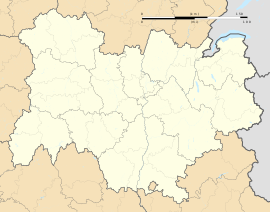Châtel-Guyon (French: [ʃɑtɛl ɡɥijɔ̃]; Auvergnat: Chastel Guion) is a commune in the Puy-de-Dôme department in Auvergne-Rhône-Alpes in central France.[4]
Châtel-Guyon
Chastel Guion (Occitan) | |
|---|---|
 Centre-ville de Châtel-Guyon | |
| Coordinates: 45°55′24″N 3°03′54″E / 45.9233°N 3.065°E | |
| Country | France |
| Region | Auvergne-Rhône-Alpes |
| Department | Puy-de-Dôme |
| Arrondissement | Riom |
| Canton | Châtel-Guyon[1] |
| Intercommunality | CA Riom Limagne et Volcans |
| Government | |
| • Mayor (2020–2026) | Frédéric Bonnichon[2] |
Area 1 | 14.06 km2 (5.43 sq mi) |
| Population (2022)[3] | 6,294 |
| • Density | 450/km2 (1,200/sq mi) |
| Demonym | Châtelguyonnais or Brayauds |
| Time zone | UTC+01:00 (CET) |
| • Summer (DST) | UTC+02:00 (CEST) |
| INSEE/Postal code | 63103 /63140 |
| Elevation | 374–721 m (1,227–2,365 ft) |
| Website | www.chatel-guyon.fr |
| 1 French Land Register data, which excludes lakes, ponds, glaciers > 1 km2 (0.386 sq mi or 247 acres) and river estuaries. | |
The name Châtel-Guyon comes from Castellum Guidonis, “Guy’s Castle”, after Guy II of Auvergne, the founder of the city.
Prior to June 2008 it was officially known as Châtelguyon,[5] the change in the official styling being an adoption of its colloquial spelling, as, for example, used by Guy de Maupassant in his 1884 short story, "Le tic".[6]
First World War
editAt the time of the First World War, the population was approximately 2000 residents.[7] It was an international destination for its baths and healing springs and attracted 30,000 visitors each summer.[8] With the onset of war the majority of the hotels were closed. Many were used by the French government for housing French and Belgian refugees, as well as for hospitals by French and other forces.[8] The American Expeditionary Force established Base Hospital No. 20 at Châtel-Guyon in May 1918.[9] The hospital ceased operations in January 1919.[10]
Population
edit| Year | Pop. | ±% p.a. |
|---|---|---|
| 1968 | 3,652 | — |
| 1975 | 3,530 | −0.48% |
| 1982 | 4,386 | +3.15% |
| 1990 | 4,743 | +0.98% |
| 1999 | 5,241 | +1.12% |
| 2007 | 6,224 | +2.17% |
| 2012 | 6,100 | −0.40% |
| 2017 | 6,152 | +0.17% |
| Source: INSEE[11] | ||
See also
editReferences
editCitations
edit- ^ "Décret 2014-210 du 21 février 2014 portant délimitation des cantons dans le département du Puy-de-Dôme" [2014-210 decree delimiting cantons of Puy-de-Dôme department]. Légifrance (in French). 21 February 2014.
- ^ "Répertoire national des élus: les maires". data.gouv.fr, Plateforme ouverte des données publiques françaises (in French). 2 December 2020.
- ^ "Populations de référence 2022" (in French). The National Institute of Statistics and Economic Studies. 19 December 2024.
- ^ INSEE commune file
- ^ Décret n° 2008-626 du 27 juin 2008 (in French)
- ^ Maupassant par les textes
- ^ History of United States Army Base Hospital No. 20 1920, p. 189.
- ^ a b History of United States Army Base Hospital No. 20 1920, p. 193.
- ^ History of United States Army Base Hospital No. 20 1920, p. 38.
- ^ History of United States Army Base Hospital No. 20 1920, p. 44.
- ^ Population en historique depuis 1968, INSEE
Sources
edit- University of Pennsylvania; United States. Surgeon-General's Office (1920). History of United States Army Base Hospital No. 20: organized at the University of Pennsylvania. E.A. Wright. OCLC 705146189.




